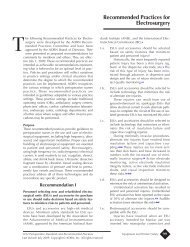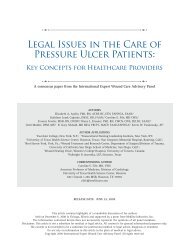2009 CAUTI guidelines - Centers for Disease Control and Prevention
2009 CAUTI guidelines - Centers for Disease Control and Prevention
2009 CAUTI guidelines - Centers for Disease Control and Prevention
You also want an ePaper? Increase the reach of your titles
YUMPU automatically turns print PDFs into web optimized ePapers that Google loves.
Category I recommendations are defined as strong recommendations with the followingimplications:1. For patients: Most people in the patient’s situation would want the recommended courseof action <strong>and</strong> only a small proportion would not; request discussion if the intervention isnot offered.2. For clinicians: Most patients should receive the recommended course of action.3. For policymakers: The recommendation may be adopted as a policy.Category II recommendations are defined as weak recommendations with the followingimplications:1. For patients: Most people in the patient’s situation would want the recommended courseof action, but many would not.2. For clinicians: Different choices will be appropriate <strong>for</strong> different patients, <strong>and</strong> cliniciansmust help each patient to arrive at a management decision consistent with her or hisvalues <strong>and</strong> preferences.3. For policymakers: Policy making will require substantial debate <strong>and</strong> involvement of manystakeholders.It should be noted that Category II recommendations are discretionary <strong>for</strong> the individualinstitution <strong>and</strong> are not intended to be en<strong>for</strong>ced.The wording of each recommendation was carefully selected to reflect the recommendation'sstrength. In most cases, we used the active voice when writing Category I recommendations -the strong recommendations. Phrases like "do" or "do not" <strong>and</strong> verbs without auxiliaries orconditionals were used to convey certainty. We used a more passive voice when writingCategory II recommendations - the weak recommendations. Words like "consider” <strong>and</strong> phraseslike "is preferable,” “is suggested,” “is not suggested,” or “is not recommended” were chosen toreflect the lesser certainty of the Category II recommendations. Rather than a simple statementof fact, each recommendation is actionable, describing precisely a proposed action to take.The category "No recommendation/unresolved issue" was most commonly applied to situationswhere either 1) the overall quality of the evidence base <strong>for</strong> a given intervention was low to verylow <strong>and</strong> there was no consensus on the benefit of the intervention or 2) there was no publishedevidence on outcomes deemed critical to weighing the risks <strong>and</strong> benefits of a given intervention.If the latter was the case, those critical outcomes will be noted at the end of the relevantevidence summary.Our evidence-based recommendations were cross-checked with those from <strong>guidelines</strong> identifiedin our original systematic search. Recommendations from previous <strong>guidelines</strong> <strong>for</strong> topics notdirectly addressed by our systematic review of the evidence were included in our "Summary ofRecommendations" if they were deemed critical to the target users of this guideline. Unlikerecommendations in<strong>for</strong>med by our literature search, these recommendations are not linked to akey question. These recommendations were agreed upon by expert consensus <strong>and</strong> aredesignated either IB if they represent a strong recommendation based on accepted practices(e.g., aseptic technique) or II if they are a suggestion based on a probable net benefit despitelimited evidence.All recommendations were approved by HICPAC. Recommendations focused only on efficacy,effectiveness, <strong>and</strong> safety. The optimal use of these <strong>guidelines</strong> should include a consideration ofthe costs relevant to the local setting of guideline users.Reviewing <strong>and</strong> Finalizing the Guideline32
















